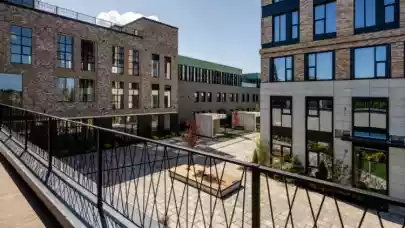
As of summer 2022, leasing activity in the Kyiv office market was near a standstill and primarily driven by office optimization, as well as lease renewals and renegotiations of existing leases, according to the latest research of CBRE Ukraine. Whereas, as of the beginning of June, we observed a slight recovery in the level of office occupancy by employees who continued to work or who returned to Kyiv. Thus, typical office attendance among corporate occupiers was ca. 10% with many tenants in IT, high tech & telecommunications, healthcare and pharmaceuticals, agriculture, FMCG and industrial sectors planning to increase occupancy to 15%.
No new business centres have entered the market in the first half of 2022. The total volume of office space remained unchanged at 2.1 million sqm. Nonetheless, according to recent developer statements, roughly 114,000 sqm of new supply may be expected to be delivered by the end of 2022, provided the complete end of hostilities some time in 2022. However, should the war not end in 2022, none of the declared properties will enter the market due to significant business risks and difficulties in obtaining relevant commissioning permits.
As of June 2022, the average vacancy rate in the office market increased to 17.7% (+3.6% pp YTD). Analysing vacancies in terms of classes, the vacancy rate in Class A grew by 2.9% YTD to 11.7% and in Class B to 21.6% (+4.3 YTD). The increase was caused by the reduction of space by larger occupiers and the relocation of smaller and local companies to more budget-friendly business centres, alongside with near-complete absence of new demand. Cost-cutting strategies took centre stage across the board, whereby corporate safety policies coupled with employee out-migration to safer regions of Ukraine and to other countries reduced the need for office space.
Under conditions of a significant market swing in tenants’ favour, tenants are actively working on obtaining more favourable terms when extending leases. Such extensions are typically short-term, and landlords show significant flexibility in providing reductions of 30%-60% for the duration of martial law or go as far as allowing rent not to be paid during martial law, with tenants responsible only for OPEX and utilities. Meanwhile asking rents for long-term leases in Class A remain at $20-$26 (-9% at the lower bound and -7% at the upper bound YTD) and $9-$20 (-25% at the lower bound and -9% at the upper bound YTD) in Class B. As for effective rent, no major transactions in high-quality Class A business centres have occurred since the beginning of the war. Considering the ongoing lease renewal deals in Class A in Q2 2022, the prime effective rent has decreased to an average of 4%-8% and is believed to stand at $23-$24 per sqm.
A positive sign over May-June 2022 is the revival of long-term plans of some international companies, which, prior to the military aggression, were planning to move to new offices in 2023-2024. Although such corporate moves, as well as the resumption of construction, are still rare, these positive signs instil the belief that the market is building in positive business dynamics for the country for the near-term future.
In the short-term perspective, CBRE Ukraine expects the situation in the office market to remain complicated, as demand – in particular, employment – will remain constrained under wartime economics. However, the experience of market reaction to the crisis years of 2008, the 2014-15 war in the Donbas and the occupation of Crimea, as well as the two-year covid-related lockdown of 2020-2021 has made the Ukrainian market more prepared to weather the current storm. If re-escalation in the region does not happen, the first trends in the market will tentatively be formed in the fall of 2022, by which time both occupiers and landlords will be gradually coming to terms with new market realities.



